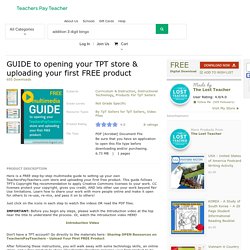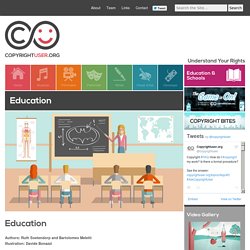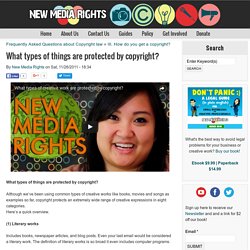

GUIDE to opening your TPT store & uploading... by The Lost Teacher. Here is a FREE step-by-step multimedia guide to setting up your own TeachersPayTeachers.com store and uploading your first free product.

This guide follows TPT's Copyright Faq recommendation to apply Creative Commons licenses to your work. CC licenses protect your copyright, gives you credit, AND lets other use your work beyond Fair Use limitations. Learn how to share your work with more people online and make it open for others to re-use, re-mix, and pass it on to others! Just click on the icons in each step to watch the videos OR read the PDF files. IMPORTANT: Before you begin any steps, please watch the Introduction video at the top near the title to understand the process.
Introduction Video Don't have a TPT account? After following these instructions, you will walk away with some technology skills, an online store, and a free product to share (TeachersPayTeachers requires your first product to be FREE). In these instructions, you have 2 choices. Prerequisite skills: 1. Copyright User – Education. Authors: Ruth Soetendorp and Bartolomeo MelettiIllustration: Davide Bonazzi The use of materials protected by copyright is essential to the learning process.

Educational resources exist in all formats that are recognised as ‘works’ in copyright law. To minimise the burden on teachers and students who want to make use of copyright materials as part of their teaching and learning experience, the law includes a number of exceptions that allow for the use of all types of copyright work for certain educational purposes.
If you are using materials in an educational context this does not mean that you can forget about copyright. What it does mean is that you need to be aware of when you can use a work without obtaining permission or paying a licence fee, and when permission or a licence is required. For example, the law makes clear that certain exceptions for education can only be relied upon in the absence of a relevant educational licensing scheme. Copyright and Fair Use for Student Projects. Copyright and Fair Use. Circ01. Copyright for teachers. Copyright: Definition According to the U.S.

Copyright Office, copyright is "a form of protection grounded in the U.S. Constitution and granted by law for original works of authorship fixed in a tangible medium of expression. Copyright covers both published and unpublished works. " Under the law, the individual or entity that owns the copyright of a work has the following rights: - Reproduction: Making copies - Adaptation: Changing a work in some way - Distribution: Giving the work to others - Public Performance: Playing/performing a work in front of others - Public Display:Displaying a work for others to view - Digital Transmission of Sound Recordings: Capturing audio files on the internet and burning CDs/file sharing Items in public domain An item is in public domain when it is no longer protected by copyright because of the age of the work (created before January 21, 1923), or it did not meet copyright requirements to begin with.
Teaching Copyright. Welcome To The FACE Kids Site. What types of things are protected by copyright? What types of things are protected by copyright?

Although we’ve been using common types of creative works like books, movies and songs as examples so far, copyright protects an extremely wide range of creative expressions in eight categories. Here’s a quick overview. (1) Literary works Includes books, newspaper articles, and blog posts. Even your last email would be considered a literary work.
. (2) Musical works Includes musical notations of all kinds. . (3) Dramatic works Includes plays, screenplays, and TV scripts. (4) Choreographic works Includes dances, ballets, and mime performances. (5) Pictorial, graphic, and sculptural works Includes paintings, drawings, photographs, and digital illustrations. (6) Motion pictures and other audiovisual works Includes movies, live webcasts that are being saved, slideshows, and video podcasts. (7) Sound recordings Now that you understand the basics, we can discuss this in more detail. (1) Literary works (2) Musical works, including any accompanying words Conclusion. Seven Categories of Copyright Law.